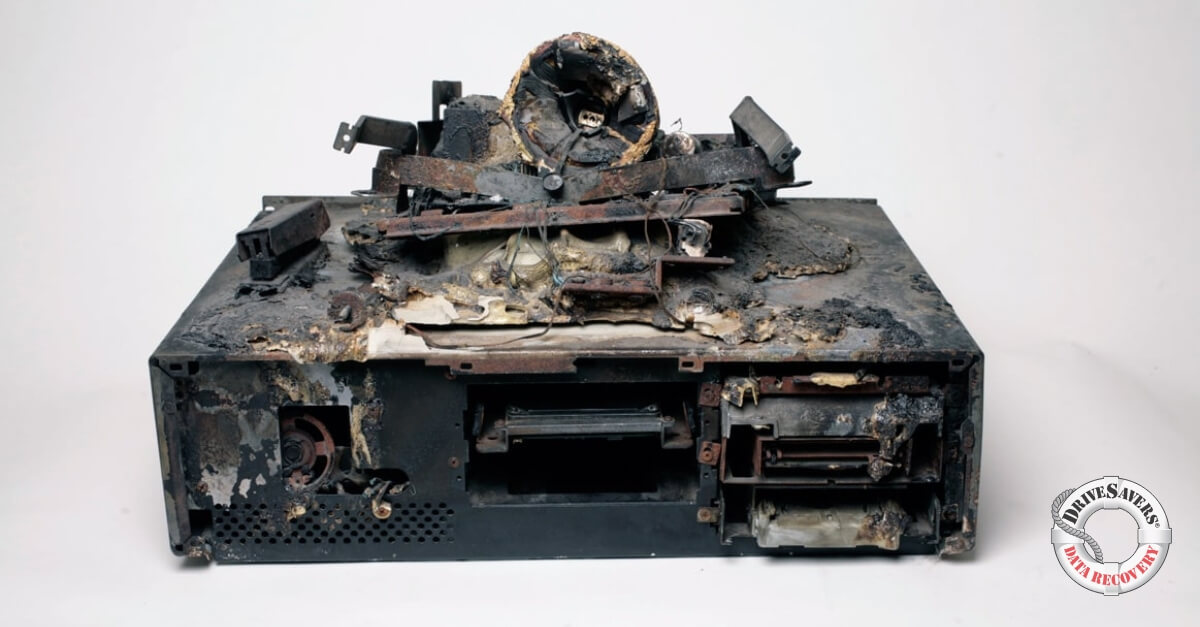Saber cómo proteger un disco duro externo con contraseña es crucial para su ciberseguridad general. Aprende a hacerlo tanto en PC como en Mac.
Dispositivos dañados por el fuego: ¿Recuperables o no?

Los ingenieros de DriveSavers adquirieron un gran conocimiento tras los incendios forestales del norte de California de 2017, una serie de quince incendios que comenzaron la noche del domingo 8 de octubre. Estos incendios se extendieron a través de los condados de Sonoma, Napa y Lake, destruyendo nuestras casas y vecindarios. Sabemos de primera mano qué tipo de daño por fuego podemos esperar ver cuando los dispositivos de los recientes incendios forestales del sur de California comiencen a llegar a nuestro laboratorio.
Históricamente, DriveSavers ha tenido mucho éxito en la recuperación de datos de dispositivos dañados por fuego; sin embargo, muchos dispositivos procedentes de incendios forestales a gran escala han sido irrecuperables. Siga leyendo para descubrir algunas señales que indican que la recuperación de datos podría ser posible.

Diferencias entre los incendios de estructuras aisladas y los incendios forestales

These expansive, long-lasting wildfires have very different qualities from the average isolated building fire.
- Temperature
- Length of time
- Additional contaminants
Temperature
Home fires usually burn around 1,000°F, while wildfires like those in Southern California can burn up to 1,800°F or even 3,000°F over time. This range of temperatures makes wildfires more damaging than house fires alone.
Another factor is direct heat versus radiated heat. In the case of an isolated structure fire, fire rescue is generally on the scene in under ten minutes from notification and will usually have the flame contained to a single room before it spreads to the rest of the house. Objects directly in the flames face higher temperatures and more damage, while those outside the flames usually endure less harm.
Length of Time
While some building fires may take several hours to extinguish, most single-family homes are put out in under an hour. Conversely, most of the homes and businesses caught up in these massive wildfires have burned continuously for twelve hours or more before simply running out of fuel for the flames. The length of time that a fire burns a data storage device matters.
One reason why length of time matters is because the longer a flame burns, the hotter it gets. Depending on the materials fueling the fire, temperatures directly inside a fire can build to over 2,200 degrees F in as little as four hours. In eight hours, this temperature can rise another 100 degrees to 2,300 degrees F. The hottest fires can burn as hot as 5,500 degrees! This is extreme, however, is not common. Most long-lasting flames, such as the Los Angeles, Palisades, and Eaton wildfires, cap out closer to 3,000 degrees.
In addition, when a home is caught in a wildfire where the fire has already been burning at extreme temperatures before reaching the building, the entire structure and its contents could ignite instantaneously. This is especially likely if there are combustible fuels present.
Additional Contaminants
Flame and heat aren’t the only attributes of a fire that may damage a computer and its data storage. Water used to put out a fire, debris, soot, and chemicals such as flame retardant can all cause additional damage.
Water and flame retardant, used by firefighters on isolated single-family home fires and other comparatively smaller incidents may be absent from devices recovered from a wildfire. This is because, once the wildfire is contained, houses toward the middle of the fire will simply burn out, or run out of fuel and extinguish on their own without aid from water or flame retardant, before firefighters are physically able to get to it.
Cómo el fuego daña a una computadora
No device is instantly and entirely destroyed by a fire, whether it is a tragic house fire or a catastrophic wildfire. Here are some common consequences.
Plastic Parts
In just about any fire, plastic components will melt. The average PC today can be anywhere from 17–40% plastic. This includes the keys in a keyboard, parts of the computer exterior case, insulation inside the case and even some capacitors and electronic circuits. Whether directly contacted with flame or affected indirectly by the heat of a fire, plastics will generally begin to melt before the temperature reaches 500 degrees F.
Rubber Seals
Hard disk drives (HDDs) and some solid-state drives (SSDs) have metal casings protecting the components that store data. These drive cases are generally sealed with an industrial strength rubber gasket. This rubber generally begins to melt at about 620 degrees F.
This does not necessarily mean the components inside are compromised at that temperature. If the rubber remains in place, even while softened, the components inside will be protected from external debris, etc.
On the other hand, once this rubber gasket on an HDD is compromised and holes, however small, can be seen in the seal, chances are the data on the device is no longer recoverable. This is because any soot, smoke or other contaminants, once inside the drive, will cause additional damage to the platters that hold the actual ones and zeros that make up data.
SSD data recovery is different from an HDD in that the chips that make up an SSD are not affected by particulate matter. If an SSD case is compromised, there may still be a good chance to recover the data.
Platters
Inside an HDD are platters that look much like round mirrors on a spindle. These disks store all of the computer’s data. Depending on the manufacturer and model, platters may be made of aluminum, glass, ceramic, cobalt, or a combination of two or more of these materials. Platters tend to be fairly durable to heat and will often withstand high temperatures before they begin to warp, bubble, or melt.
Metal
Computers are mostly made of metal. The outer case, controller chips, memory chips (in an SSD), connectors, circuits, and several other components are generally composed of various types of metal:
- Exterior: usually aluminum
- Memory or NAND chips: usually silicon
- Circuits: usually silicon
- Other components may be composed of lead, copper, gold, or tin
Silicon, in particular, is very resistant to heat and can survive temperatures up to 2,500 degrees F. It is important to note that, even at lower temperatures, durability of silicon and most other metal breaks down as heat or flame exposure is prolonged. Every minute can count when it comes to having a chance for your storage device or the data on it to survive.

Cómo determinar sus datos pueden recuperarse
Estas son algunas de las cosas en las que hay que fijarse para determinar si los datos pueden recuperarse o no de un dispositivo dañado por el fuego.
¿Hubo agua?
Muchos hogares y oficinas cuentan con aspersores contra incendios que se activan con el calor. En este caso, aunque el edificio se incendiara, la existencia de un sistema de aspersores en funcionamiento podría haber bastado para enfriar la computadora y evitar la pérdida permanente de datos.
Cuando los bomberos acuden a un edificio en llamas, sofocan las llamas con miles de litros de agua. Incluso si no hubiera aspersores en una vivienda, habrá agua de sobra para afectar a las computadoras y otros aparatos.
En alguna de estas dos situaciones, en lugar de daños por calor o fuego, un dispositivo seguramente tendrá daños por agua. Si este es el caso, tráigalo a DriveSavers de inmediato para recuperar sus datos antes de que la corrosión causada por el daño del agua pueda extenderse.
¿La computadora está carbonizada o derretida?
Si la computadora está derretida, pero no hay evidencia de contacto directo con las llamas, como carbonización, las probabilidades de que los datos sean recuperables son bastante altas. Pero si observa carbonización, aún no pierda la esperanza.
¿El dispositivo tiene etiquetas adhesivas?
Si todavía hay etiquetas adhesivas del fabricante en su disco duro u otros componentes internos de su computadora, eso es una excelente señal de que el calor no fue lo suficientemente intenso como para causar una pérdida permanente de datos y que su información podría ser recuperable.
¿Qué tan intacta está la carcasa del disco duro?
Aunque el exterior de la computadora esté derretido o carbonizado, lo que realmente importa es el estado del disco duro en sí.
Si es capaz de localizar el disco duro dentro de la computadora y todavía está entero, sin daños en la junta de goma que mantiene la carcasa unida, hay una buena probabilidad de éxito en la recuperación de datos.
Muchas de las computadoras que recibimos de los incendios del norte de California tenían unidades de disco que se habían derretido o que estaban hechas cenizas. Si ya no queda nada de la unidad de disco de una computadora, entonces no hay nada que podamos hacer para recuperar los datos.
¿Puede identificar algún chip?
Si puede encontrar chips que parezcan estar enteros, es probable que la unidad de disco de la computadora también esté entera y pueda recuperarse. Esto es aplicable a los chips de una placa base y, en particular, a los chips de una unidad de estado sólido (SSD) u otro tipo de memoria flash que estén enteros y relativamente intactos.
¿No está seguro de si sus datos se pueden recuperar? Llame a DriveSavers.
Nuestros asesores de recuperación de datos le ayudarán a determinar si su dispositivo de almacenamiento de datos puede ser recuperable. Le proporcionaremos una etiqueta de envío express gratuita para que DriveSavers pueda realizar una evaluación gratuita del dispositivo e informarle sobre las posibilidades de recuperar sus datos.
Llame al 1 (800) 440-1904. Los asesores de recuperación de datos de DriveSavers están disponibles 24/7 y pueden comenzar el proceso de recuperación de sus datos de inmediato.




